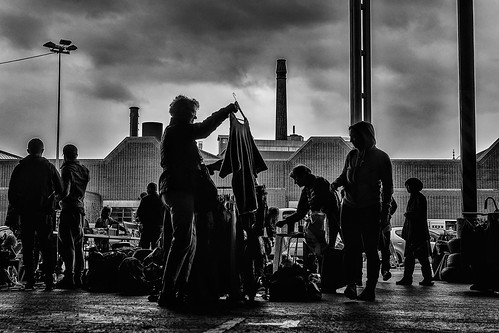Flea markets in Poland Posted by Kasia on Jul 11, 2014 in Culture
Flea markets (pchle targi), understood as places where you could sell/buy or barter (prowadzić handel wymienny) low quality goods with others, while chatting away on the actual need to have this or that item, are probably a thing of the past in Poland. The Internet has replaced the bricks and mortar trading spots by creating a virtual marketplace where unnecessary goods or items can be showcased and, hopefully, sold. An example of this is Tablica.pl offering free postings, which, combined with the growing population of Internet-enabled households, adds to the attractiveness of the media as it is no longer necessary to move, sometimes highly bulky goods, to a designated trading spot.
Obviously, most Polish towns and cities would have a designated marketplace (rynek or targ), or a bazaar (bazar) where trading can take place. Supplied chiefly by the neighboring farmers, these places usually offer fresh fruit and vegetables (my parents still visit these places to sell apples), herbs, fresh meat and cold cuts, but also all sorts of other items and services, such as cleaning or household supplies, shoe repairs or tailor services. The prices offered are attractive (even better than those in the supermarkets) and the food is fresh, with a much better selection than that of your everyday corner shop. If you become a regular, you might even get to know the sellers personally, and possibly obtain slightly better prices than others who do not have the privilege of mingling with the ones entitled to trade (this being considered a sort of a distinction in the eyes of the sellers).
Quite different from the usual food market would be clothes bazaars (bazary ubraniowe) and antiques markets (targi staroci). The first type is something that developed rapidly in the early 1990s when Poland was going through the social and economic transformation. For lack of acceptable clothing fashion and prices at high street stores, Poles soon understood it was much better to stroll through a clothes bazaar, with the notable example being the 10th Anniversary Stadium (Stadion Dziesięciolecia) in Warsaw (currently one of the most prestigious and modern sports facilities in Europe, the National Stadium – Stadion Narodowy) which, while no longer in use for sporting events, became the largest trading area in Europe) where one could get any type of clothes and accessories, even those bearing the well-known international labels. No one really cared whether they were genuine – what mattered was the label itself. Most of the goods were provided and sold by traders from the Far East, so it was not unusual to hear a lot of Chinese or Vietnamese at the bazaar. This quickly became the place to be for all those fashion trend-conscious. However, high street stores and large shopping centers were also developing, attempting at the same time to educate Jan Kowalski in terms of quality and genuineness of the clothes they buy, while Jan Kowalski started to make more money. It took some time before Poles finally understood that the bazaar offering was not exactly the type of goods they were looking for, and gradually switched to shopping for branded clothes at large shopping centers.
Antiques markets, on the other hand, are places where people would be looking for old or period items to adorn (ozdobić) their homes. These are usually supplied by clever craftsmen who can actually transform an ordinary item into an attractive-looking “antique”. It has not been unusual to spot IKEA-branded pieces of furniture at these markets, made to look dated and worn only to attract the attention of those less knowledgeable. However, there would naturally be a circle of true believers in the wonders you can chance on when strolling through these markets. It’s certainly well worth a try. You’ll mostly find these in larger cities, and if you happen to visit the place again, you’ll notice that most of the sellers are the same people all the time, selling stuff which no one actually wants, but make potential customers believe the objects they have are special and unique. Udanych zakupów! (Happy shopping!)
Do następnego razu… (Till next time…)

Build vocabulary, practice pronunciation, and more with Transparent Language Online. Available anytime, anywhere, on any device.
About the Author: Kasia
My name is Kasia Scontsas. I grew near Lublin, Poland and moved to Warsaw to study International Business. I have passion for languages: any languages! Currently I live in New Hampshire. I enjoy skiing, kayaking, biking and paddle boarding. My husband speaks a little Polish, but our daughters are fluent in it! I wanted to make sure that they can communicate with their Polish relatives in our native language. Teaching them Polish since they were born was the best thing I could have given them! I have been writing about learning Polish language and culture for Transparent Language’s Polish Blog since 2010.




